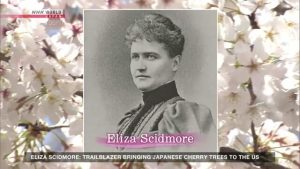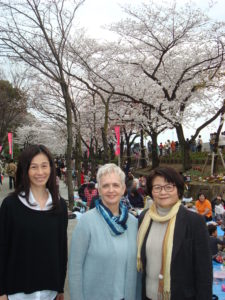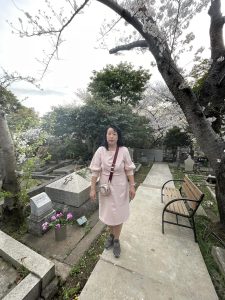A Scidmore Sisterhood, Across Cultures

With Miki Ebara along the banks of the Tidal Basin in Washington, in October 2024. (Photo: Ralf Oberti)
Japanese TV reporter Miki Ebara plans to make a documentary of Eliza Scidmore. Meanwhile, she turned some of her footage into a 12-minute feature on Scidmore and my first-ever biography of her, for Japan’s NHK World (an English-language channel). It aired on March 27, 2024, during cherry blossom season in Washington and Japan.
March 27 is regarded as “Sakura Day” in Japan, acccording to Chiaki Umemoto, representative director of the Eliza Scidmore Cherry Blossom Society in Yokohama. Sakura is the Japanese term for cherry blossoms. That date is significant because it’s the anniversary of when the first cherry trees sent as a gift from Japan were planted in 1912 along the Tidal Basin in Washington.
In October, Miki and I were filmed along the Tidal Basin when she was in town for a day of filming. The photo reprises a picture of us taken near the same spot 10 years ago. Back then, I was heading to Japan for a month of research, which I timed for late March 2013 so I could “walks in the footsteps” of Eliza Scidmore by strolling under the trees at Mukojima and Ueyno Park in Tokyo.
Learning of my plans in 2013, Miki arranged for me to be interviewed for NHK. We did some filming in Washington, before she passed me along to her colleagues in Tokyo. That TV segment, which aired on the evening news, highlighted my research into Scidmore’s life, then in an early stage. Scidmore is a fairly well known figure in Japan and is interred at the Foreign General Cemetery in Yokohama, which I visited.
This time around, Miki highlighted my now-completed book in the first half of the March 27 program on NHK. She devoted the rest of the program to the efforts of Chiaki and her group to spread the word about Scidmore and her legacy in Japan. The campaign includes visits to schools where children plant saplings propagated from genetic stock of the first cherry trees in Washington.
Miki and I have worked together several times over the years, and I’m honored to call her a good friend. We were delighted to find a lot of overlap in our lives, as journalists, March birthday girls and former recipients of Rotary international fellowships.
She first contacted me a decade ago out of the blue soon after I launched a modest website and blog to chronicle my research on Scidmore. It was quite a surprise to hear Miki say she KNEW about Scidmore. Most people I encountered drew a blank on the name. Miki told me she covered disasters and was familiar with Scidmore in part through her article in National Geographic on a deadly 1896 tsunami on the northeast coast of Japan.
When I got ready for my research trip to Japan in 2013, Miki offered tons of helpful advice on logistics and planning. In a huge boon to my research, she referred me to many people who provided on-the-ground assistance in tracking down sources and records.
Along with Chiaki, we think of ourselves as a sort of Eliza Scidmore sisterhood, passionate about telling her story.
I’m also indebted to two other early members of our “club”: fellow Scidmore fan girls Anne McClellan and Andrea Zimmerman. Ann is a well established Washington expert on cherry trees as the author of Cherry Blossoms and The Cherry Blossom Festival: Sakura Celebration. She has a new book on the subject coming out in the spring of 2025. Andrea wrote a children’s book on Scidmore, Eliza’s Cherry Trees. It was published in 2011, and I fortuitously met Andrea when she was in town promoting the book. She too was a great source of leads early in my research.

NHK World program on Eliza Scidmore, aired on March 27, 2024.

Along the Tidal Basin, at the original cherry tree planting spot, with NHK reporter Miki Ebara in March 2013.

Kyoko Tanitsu, left, and Michiko Okubo were my companions and guides when I visited Mukojima in March 2013. (Photo: Wakako Hisaeda)

Chiaki Umemoto, next to the gravesite of Eliza Scidmore and her mother and brother in Yokohama’s Foreign General Cemetery.